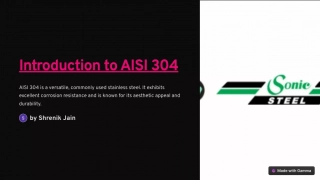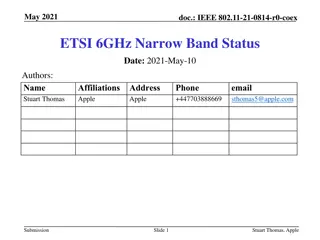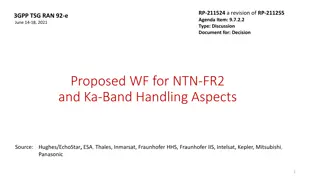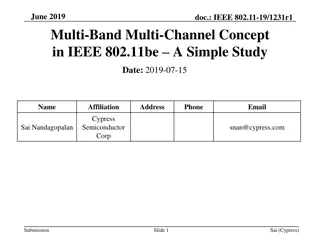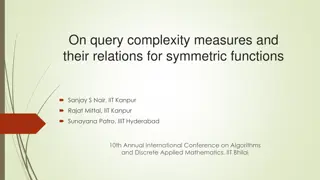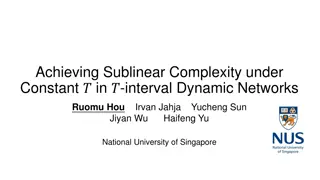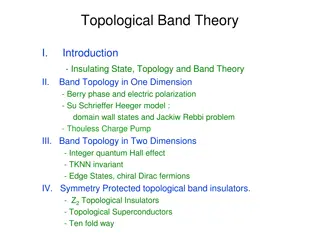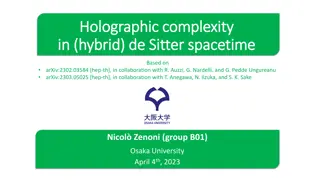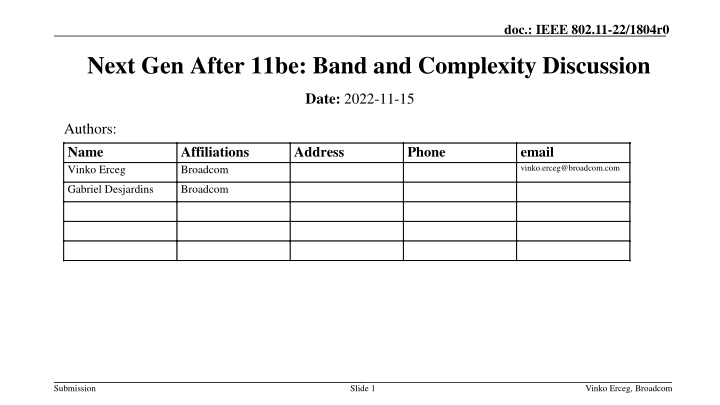
Evolution of IEEE 802.11 WLAN Standards and Product Form Factors
Explore the progression of IEEE 802.11 WLAN standards and product complexities post-11be. From band support to product form factors, dive into the technological advancements and industry adaptations shaping the future of wireless communication.
Download Presentation

Please find below an Image/Link to download the presentation.
The content on the website is provided AS IS for your information and personal use only. It may not be sold, licensed, or shared on other websites without obtaining consent from the author. If you encounter any issues during the download, it is possible that the publisher has removed the file from their server.
You are allowed to download the files provided on this website for personal or commercial use, subject to the condition that they are used lawfully. All files are the property of their respective owners.
The content on the website is provided AS IS for your information and personal use only. It may not be sold, licensed, or shared on other websites without obtaining consent from the author.
E N D
Presentation Transcript
doc.: IEEE 802.11-22/1804r0 Next Gen After 11be: Band and Complexity Discussion Date: 2022-11-15 Authors: Name Vinko Erceg Affiliations Broadcom Address Phone email vinko.erceg@broadcom.com Gabriel Desjardins Broadcom Submission Slide 1 Vinko Erceg, Broadcom
doc.: IEEE 802.11-22/1804r0 Outline Band Support Products Progression 802.11 Complexity Progression Discussion and Conclusions Submission Slide 2
doc.: IEEE 802.11-22/1804r0 Band Support Products Progression Technology 5 GHz MIMO 60 GHz/802.11ad 160 MHz Technology 802.11ac 802.11ax Ratified 1999 2009 2012 2013 Ratified 2013 2019 100Mu Smartphone Shipments 2011* 2015 N/A Expected 2023 100Mu Smartphone Shipments 2013 2019** Scope of Product Hardware Changes Additional antenna and diplexer Two additional antennas and one diplexer Additional chip(s), module, antenna array Front-end and antenna re-design for 6 GHz Scope of Product Hardware Changes Minor front-end changes for 256-QAM/80 MHz Minor front-end changes for 1024-QAM*** Technologies requiring major hardware modifications (e.g. new band support, additional or more complex antennas) have historically seen very slow uptake Technologies with major MAC/PHY development but more limited hardware modifications have been immediately successful * PC shipments exceeded 100Mu earlier than 2011, but when smartphones became a major product category, they only supported 2.4 GHz for several years ** 80 MHz/5 GHz only *** Numerous suppliers enabled proprietary 1024-QAM for 802.11ac; no changes were required in those cases to enable 802.11ax Submission Slide 3
doc.: IEEE 802.11-22/1804r0 802.11 Complexity Progression Mainstream WLAN started with 20 MHz and single antenna - 11b, 11g Dimensions increased Wider BWs in 11a MIMO in 11n Dimensions further progressed in 11ac/ax/be Up to 320 MHz BW Up to 16 antennas Progression of these specifications translated into products 8 antenna APs 3 and 4 antenna STAs 320 MHz BWs Submission Slide 4
doc.: IEEE 802.11-22/1804r0 Regression Seems to Have Taken Place What happened to 8 antenna APs? Seem to be scaling back 4 antenna AP are becoming a norm 8 Antenna APs are rare (some in Enterprise) What happened to 3 and 4 Antenna STAs? Diminished, very few products in the market 2 antenna STAs are currently a norm Submission Slide 5
doc.: IEEE 802.11-22/1804r0 Possible Reasons for Regression? Peak throughputs strong Mainly exceeding data-rate feeds into homes Availability of new 6GHz band Less congestion Better system throughput Decrease in latency and throughput increase through MLO EMLSR, STR, NSTR, . Cost Submission Slide 6
doc.: IEEE 802.11-22/1804r0 Discussion and Conclusions (1) New spectrum adoption takes time, 1.2 GHz of spectrum was made available in many regions of the world just recently It will take at least one more generation of WLAN to start utilizing this new spectrum fully and effectively It is very hard to visualize, successfully (market adoption) adding new mmWave modem to WLAN at this point given cost trends, complexity trends, and 6GHz spectrum availability Sub-7GHz products have yet to see widespread adoption of MLO, 3-4 antenna STAs, 8 antenna APs and 320 MHz BWs ~8x throughput gain over today s mainstream Before all this happens there seem to be no need to re-develop mmWave technology Submission Slide 7
doc.: IEEE 802.11-22/1804r0 Discussion and Conclusions (2) mmWave technology may gain traction in the future, but as we see it not in UHR mmWave Complexity/Cost Antenna arrays Front ends PHY (much more than just up-clocking of existing .11 PHY), MAC RF, antennas, beamforming/tracking - (most complexity) Multiple presentations in WNG and UHR SG show numerous features/techniques that address QoS, Latency, Reliability, Security, Channel Access, Throughput, Range, etc. Combined with enhancements such as extended MLO, 3-4 antenna STAs, 8 antenna APs and 320 MHz BWs, will result in a very strong UHR standard and products (enhancements + UHR) complexity/cost << (mmWave) complexity/cost Submission Slide 8
doc.: IEEE 802.11-22/1804r0 Discussion and Conclusions (3) Leave mmWave technology for the next decade in order not to risk evolution path of mainstream WLAN Better to use resources to improve mainstream WLAN Submission Slide 9 Vinko Erceg, Broadcom


